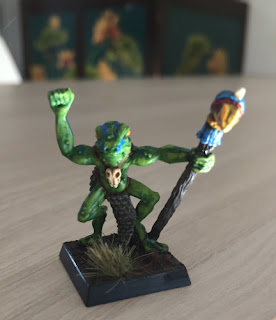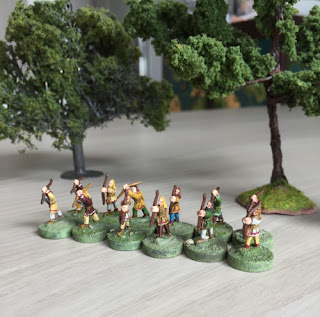The other day I was thinking that Fantasy owes its identity to illustrators as much as it does to the writers who created it. We've all heard about R.E. Howard, J.R.R. Tolkien, M. Moorcock, G.R.R. Martin, but the worlds they imagined would not be half lively as they are without those who drew them and painted them.
So I thought to start this section of my blog dedicated to these people, and to call it "Fantasy Visuals". Where to start? From the guy who inspired these thoughts, one of the under-credited giants of Fantasy whom I rediscovered last week. Gary Chalk.
Gary Chalk is a character of a man, a hero of the 80s whose professional life has gone up and down as he chased his dreams and followed his heart. Whereas many illustrators were happy doing their things behind a desk, Gary Chalk was doing a bit of everything. Game designer? Check. Entrepreneur? Check. Rebel against the system? Check.
Chalk was born in 1952 in Hertfordshire, a rural area just north of London. Since an early age, he was interested in wargames and history and showed great creativity. After achieving a BA in Art, Gary Chalk wanted to become an illustrator for children books, and moved to London where he started working for design studios in advertising, instead, waiting for his chance to follow his own road. It was at this time that he became interested in fantasy art and started developing his own drawing style which, incidentally, employed techniques of his own device since, by his own admission, he hadn't paid much attention at Art School. Mark this, because it shows already a side of the author's character which would be a trademark: independence from any teacher or master, and a genuine anarchic attitude towards any system that refuses to be bettered.
More or less in these years he became frustrated with traditional wargames, which were all about heavy rules and strategy, and he developed his own set of rules: faster, funnier and with a closer look on individuals. This is how Cry Havoc was born, a game that to this day has a following of devoted fans. It was 1981.
Gary had developed the game single-handedly: rules, typing, illustration, printing and sales. No wonder he found it difficult to succeed: the task was too much more one person. At this time, Gary Chalk met a guy who was an employee in a shop of wargames, and kindly agreed to stock Cry Havoc and try to sell it. The guy's name was Joe Dever.
Around the end of 1982 Gary was noticed by two young entrepreneurs who were also in the gaming industry, but with a more businesslike vision: these were Ian Livingstone and Steve Jackson, the founders of Games Workshop. They hired Gary with the title of Game Developing Manager and put him to work on a game they had just acquired from its author, R. Harris: it was about children competing to become prefect of the school, but the guys at GW wanted to change it to a fantasy setting. Chalk completely redesigned the board and illustrated all the cards. Renamed "Talisman", the game was launched in 1983 and it has since become one of the most popular boardgames ever.

For the art of Talisman, Gary Chalk inspired himself to the drawings of Dungeons & Dragons (mostly by Larry Elmore, but also Jeff Easley, Timothy Truman and Keith Parkinson), which was also imported and distributed by GW, but soon he developed his own distinctive style, less realistic and epic, more funny and detailed than the source. Characters had caricature-like traits, big heads, eyes, hands and feet, fancy helms and hats, long hoods, and clothes and weapons very much rooted in history rathern than imagination.
Chalk went on to work as illustrator on several issues of White Dwarf and followed closely the product "Blood Bath at Orc's Drift" (1985), for which he produced almost all the art.
It is to Gary Chalk that Fantasy owes the early depictions of Goblins with pot-helms or horned helms, scale or chain mail and cruel slant eyes.
Chalk was very fond of heraldry and very good at it. He developed shields, banners and general devices for Goblinoids, Elves, Fimir and many others.
He liked to have Elves and Rangers dress in green clothing with hoods, all with lobed edges reminding of oak leaves. Really, not much says 80s fantasy like these things that would completely disappear in the 90s.
And then, more and more magicians in colourful and fancy robes. Look at these things, and you will recognize old school Warhammer. The influence of Gary Chalk on this has been truly great, and yet underestimated by many, first of all the very company employing him, Games Workshop, and for a number of reasons.
What happened then? According to Gary, at that time Ian Livingstone and Steve Jackson, besides their main business with wargames, were writing game-books for the Fighting Fantasy series published by Puffin, a division of Penguin. The books were successful but the authors didn't have much time to write as they had to run a company, too. So they offered Joe Dever and Gary Chalk to ghost-write game-books for them. The catch was, according to Chalk, "a princely royalty of 1%" on the sales. Chalk went to Joe Dever, whom at this time was working in GW's warehouse, and convinced him to sidestep the employers.
The result was "Flight from the Dark", the first adventure of Lone Wolf, published in 1984 by Hutchinson Publishing. If you have ever heard the name Lone Wolf, and probably you do, you also know that the series was very succesful, certainly more than the books written by Livingstone and Jackson whom, I imagine, were not at all pleased, considering Gary Chalk and Joe Dever were also recipients of full time wages at the company.
No wonder then that the relation between employers and employees soon deteriorated and Dever and Chalk left GW to pursue independent careers. Chalk was already very critical of GW's approach to gaming which was, in his view, too much on the side of business and too little on the side of pleasing the fans.
But who cared? They had Lone Wolf! For a lot of teenagers in the '80s and '90s, this was the introduction to Fantasy and Role-playing games. Gary Chalk's illustrations, made between 1984 and 1987, had an imprinting effect on a generation of fans worldwide. The series sold more than 9 million books.
The attitude of GW was mixed at this time. They were threatening to sue the authors but, since technically they never signed a contract with them, it was difficult to bring any evidence in court. Yet Citadel produced a range of miniatures dedicated to Lone Wolf, so an agreement should have been reached. But Gary Chalk didn't like GW and the feeling was mutual. In 1986 the company moved their premises from London to Nottingham and word is that Gary Chalk's original art made its way to the garbage, and before some colleagues could save it, the drawings and painting had been destroyed by rain.
Gary Chalk worked together with Joe Dever for many years but after a time he longed for new projects. Having put aside some money, he decided to face GW directly: at this time, the fan base was already moaning about changes and Chalk thought he could give them something better than Warhammer, some game with realism, fun and a fair price policy. Together with Ian Bailey, another of GW's ex-staff, in 1990 he launched Fantasy Warlord.
The venture was a spectacular failure, where everything went wrong with partners and the fans. As economic crisis hit the UK, suppliers went bankrupt before they could deliver goods and services, and fans didn't buy as much as expected. This marked the beginning of bad times for Gary Chalk whom, at length, decided to give up the business of fantasy gaming and painting, and dedicated himself to his first true passion, making illustration for children books.
Today he lives in Normandy where he is able to get commissions from all over Europe and the US. Recently, he did some more works based on Lone Wolf for a kickstarted boardgame. He is often invited at conventions and interviewed by fans, and many of them can be found on the internet.
It is difficult, after all, to leave behind the success he had, and the fact that for a few years in the 80s he has produced works that set him among the Fathers of Fantasy.
So here's a number of pictures to mark the main elements of his wonderful style:
Magicians fighting Gobli-I mean, Giaks!
(BTW, Banedon was the coolest character in the series)
Evil warriors in heavy armour, their faces covered in baroque helms!
Highly detailed portraits of side characters, with realistic depictions of clothes and trappings, and caricature-like drawings of faces. Truly, nothing says Gary Chalk art more than these cartoonish faces of innkeepers, travellers and thugs.
Monsters also share the caricature-like traits, mixing human and animal elements with wholly fantastic features.
I close with a piece of art that is probably my favourite among Gary Chalk's work: the victory of Sommlending forces at Ruanor, against the Vassagonian bandits of Baraka. This drawing is just perfect, old school fantasy art at its highest. Thank you, Gary. Thank you truly.






























